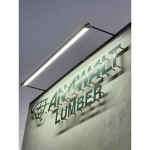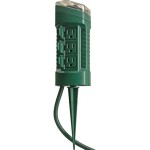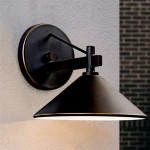How To Wire Outdoor Lights with a Light Sensor
Outdoor lighting enhances the safety, security, and aesthetic appeal of a property. Automating outdoor lights with a light sensor adds convenience and energy efficiency, turning lights on at dusk and off at dawn without manual intervention. This article provides a comprehensive guide to wiring outdoor lights with a light sensor, encompassing safety precautions, essential tools, and step-by-step instructions.
Before commencing any electrical work, it is imperative to prioritize safety. Electricity can be hazardous, and improper wiring can lead to electrical shocks, fires, or damage to electrical appliances. Adhering to local electrical codes and regulations is crucial. If unsure about any aspect of the wiring process, consulting a qualified electrician is strongly recommended.
Safety Precautions:
1. Turn off the Power: The first and most important step is to disconnect the power supply to the circuit at the main electrical panel. This can be accomplished by switching off the circuit breaker that controls the outdoor lighting circuit. Double-check that the power is off by using a non-contact voltage tester on the wires to be worked on.
2. Wear Appropriate Safety Gear: Wear insulated gloves and safety glasses to protect against electrical shocks and debris. Remove any jewelry or metallic objects that could conduct electricity.
3. Work in Dry Conditions: Avoid working on electrical wiring in wet or damp conditions, as water increases the risk of electrical shock.
4. Follow Local Codes: Ensure that all wiring and connections comply with local electrical codes and regulations. These codes are designed to ensure the safety and functionality of electrical installations.
Essential Tools and Materials:
Before beginning the wiring process, gather the necessary tools and materials:
1. Light Sensor: Choose a light sensor that is compatible with the voltage and wattage of the outdoor lights. There are different types of light sensors available, including photocells and motion sensors combined with light sensors. Select one that meets the specific needs and preferences.
2. Outdoor Lights: Ensure that the outdoor lights are suitable for outdoor use and are rated for wet locations. LED lights are a popular choice due to their energy efficiency and long lifespan.
3. Electrical Wiring: Use the appropriate gauge of electrical wiring for the circuit. The wire gauge is determined by the amperage of the circuit and the distance the electricity needs to travel. Consult an electrician or electrical code book to determine the correct wire gauge.
4. Wire Connectors: Use wire connectors (wire nuts) to securely connect the wires. Choose wire connectors that are rated for the gauge of wire being used.
5. Electrical Tape: Use electrical tape to insulate and protect the wire connections. Choose electrical tape that is rated for outdoor use.
6. Tools: Gather the following tools: wire strippers, wire cutters, pliers, screwdriver (Phillips and flathead), non-contact voltage tester, electrical multimeter, drill, and level.
Wiring Instructions (General Guide):
The specific wiring instructions may vary depending on the type of light sensor and outdoor lights being used. Refer to the manufacturer's instructions for both the light sensor and the outdoor lights for detailed wiring diagrams. This guide provides a general overview of the wiring process.
Step 1: Preparation
Turn off the power to the circuit at the main electrical panel. Verify that the power is off using a non-contact voltage tester.
Step 2: Mounting the Light Sensor
Choose a suitable location for the light sensor. The location should be free from obstructions and should receive natural sunlight. Mount the light sensor according to the manufacturer's instructions. Most light sensors are mounted on a junction box. Ensure that the junction box is weatherproof and properly sealed.
Step 3: Wiring the Light Sensor
Most light sensors have three wires: a hot (black), a neutral (white), and a load (usually red). Connect the hot wire from the power source to the hot wire on the light sensor. Connect the neutral wire from the power source to the neutral wire on the light sensor. Connect the load wire from the light sensor to the hot wire of the outdoor lights. The neutral wire from the outdoor lights should be connected to the neutral wire from the power source. Use wire connectors to make secure connections. Wrap the wire connectors with electrical tape to provide additional insulation and protection.
Step 4: Wiring the Outdoor Lights
Mount the outdoor lights in the desired location. Connect the hot wire from the light sensor to the hot wire of the outdoor lights. Connect the neutral wire from the power source to the neutral wire of the outdoor lights. Use wire connectors to make secure connections. Wrap the wire connectors with electrical tape to provide additional insulation and protection.
Step 5: Grounding
Ensure that all metal parts of the light sensor and outdoor lights are properly grounded. Connect the ground wire (usually green or bare copper) from the power source to the ground terminal on the light sensor and the outdoor lights. This grounding provides a path for stray electrical current and helps to prevent electrical shock.
Step 6: Testing
After completing the wiring, turn the power back on at the main electrical panel. Test the outdoor lights to ensure that they turn on at dusk and off at dawn. If the lights do not function properly, double-check the wiring connections and consult the manufacturer's instructions.
Step 7: Weatherproofing
Ensure that all connections and wiring are properly weatherproofed. Use weatherproof junction boxes and seal any openings with silicone caulk to prevent moisture from entering the electrical system.
Key Point 1: Understanding Wiring Diagrams
Accurate interpretation of wiring diagrams is paramount. Both the light sensor and the outdoor lights will include wiring diagrams, which are visual representations of how the components should be connected. These diagrams typically use standardized symbols to represent wires, connectors, and electrical components. Careful study of these diagrams will significantly reduce the risk of wiring errors. The essential wires to identify are the hot (live), neutral, ground, and load wires. Incorrectly connecting these wires can lead to malfunctioning lights or, more seriously, electrical hazards.
The wiring diagram will also specify the voltage and amperage requirements for the components being used. Make sure the outdoor lights and the light sensor are compatible with the existing electrical system's voltage. Wiring a 120V light fixture to a 240V circuit, for example, would damage the fixture and pose a safety risk. Similarly, using an incorrect wire gauge can cause overheating and fire hazards. If the wiring diagram shows a ground wire connection, never omit it. Grounding is a safety measure to protect against electrical shock in case of a fault.
Key Point 2: Selecting the Right Light Sensor
The market offers diverse types of light sensors, each with its own advantages and disadvantages. The most common type is the photocell, which uses a light-sensitive resistor to detect ambient light levels. When the light level drops below a certain threshold, the photocell activates the lights. Photocell sensors are relatively inexpensive and easy to install, making them a popular choice for residential applications. However, they may be affected by nearby artificial light sources, which can cause them to switch on and off prematurely.
Another type of light sensor is the motion sensor with integrated light sensitivity. These sensors combine motion detection with light sensing to turn on lights only when motion is detected in low light conditions. This offers an added layer of security and energy savings compared to simple photocells. They are better suited for areas where lights are needed only when someone is present, such as walkways or driveways. Select a sensor with adjustable sensitivity and range to minimize false triggers. Consider models that are weather-resistant and durable enough to withstand outdoor conditions.
A third type is the timer-based sensor, which turns on and off lights based on a pre-programmed schedule. While not strictly light sensors, they can simulate the function of a light sensor by turning on lights at dusk and off at dawn based on the time of year. These may require adjustment over the months as the sunrise and sunset times change.
Key Point 3: Ensuring Weatherproof Connections
Outdoor electrical connections are exposed to the elements, including rain, snow, and temperature fluctuations. Moisture can corrode electrical connections, leading to malfunctions, short circuits, and even electrical fires. Therefore, ensuring weatherproof connections is crucial for the safety and longevity of the outdoor lighting system. Use only weatherproof junction boxes and fittings that are specifically designed for outdoor use. These boxes typically have rubber gaskets and tight-fitting covers to prevent water from entering.
When connecting wires, use wire connectors (wire nuts) that are rated for outdoor use. These connectors are filled with a silicone sealant that prevents moisture from reaching the wires. After connecting the wires, wrap the connectors with electrical tape to provide an additional layer of protection. Overlap the tape generously and ensure that it is tightly wrapped to seal out moisture. Another effective measure is to use heat-shrink tubing over the wire connections. Heat-shrink tubing shrinks when heated, creating a tight, waterproof seal around the connection. After installing the light sensor and outdoor lights, inspect all connections for any gaps or openings. Seal any such areas with silicone caulk to prevent water from entering. Regularly check the outdoor lighting system for any signs of damage or corrosion. Replace any damaged components immediately to maintain the safety and integrity of the electrical system.
Finally, consider the location of the light sensor and outdoor lights. Avoid installing them in areas where they are directly exposed to rain or snow. If this is unavoidable, use a protective cover or shield to deflect water away from the electrical components.
Properly wiring outdoor lights with a light sensor enhances both the functionality and safety of a property. By following the safety precautions, utilizing the right tools and materials, and adhering to the wiring instructions, individuals can achieve reliable and energy-efficient outdoor lighting. Prioritizing safety and compliance with local electrical codes is paramount. In cases of uncertainty, seeking the expertise of a qualified electrician is highly recommended.

Zenith Motion Sensor Wiring Diagram Outside Lights To Handyman Wire Home Electrical

Elegant Wiring Diagram Ceiling Light Diagrams Digramssample Diagramimages Wiringdiagramsam Outdoor Flood Lights Sensor Lighting Wire

How To Add Motion Sensor Outdoor Lights With Or Function Doityourself Com Community Forums

Diagrams Digramssample Diagramimages Wiringdiagramsample Wiringdiagram Check More At H Led Outdoor Lighting Security Lights Light Fixtures

How To Wire Motion Sensor Occupancy Sensors

How To Wire Motion Sensor Occupancy Sensors

Motion Sensor Wiring Diagram Lights Outdoor

Unique Wiring Diagram For Outdoor Motion Detector Light Diagrams Digramssample Diagramimage Flood Lights Sensor Lighting Wire

Photocell Sensor Wiring Practical

How To Add Motion Sensor Outdoor Lights With Or Function Doityourself Com Community Forums







